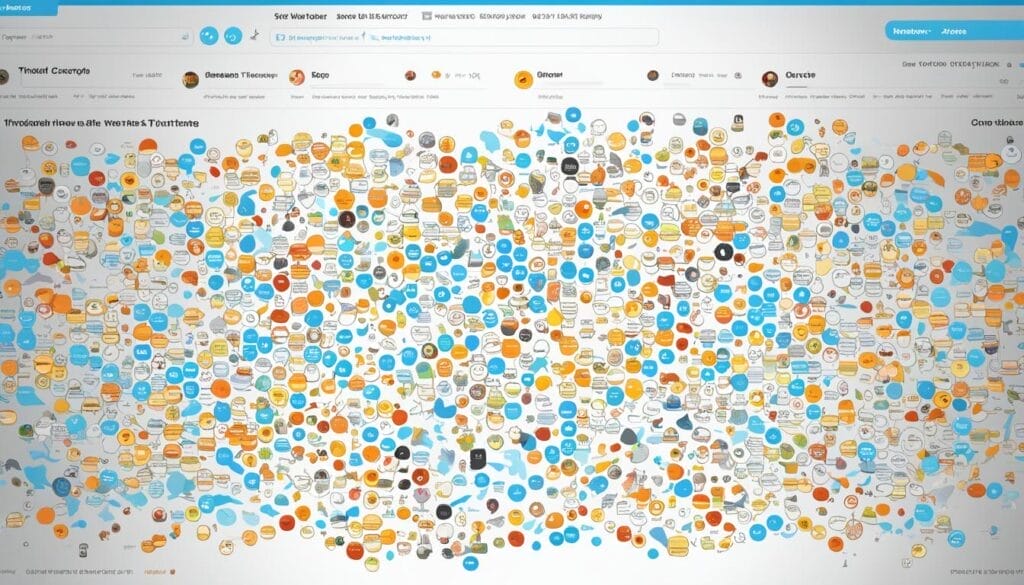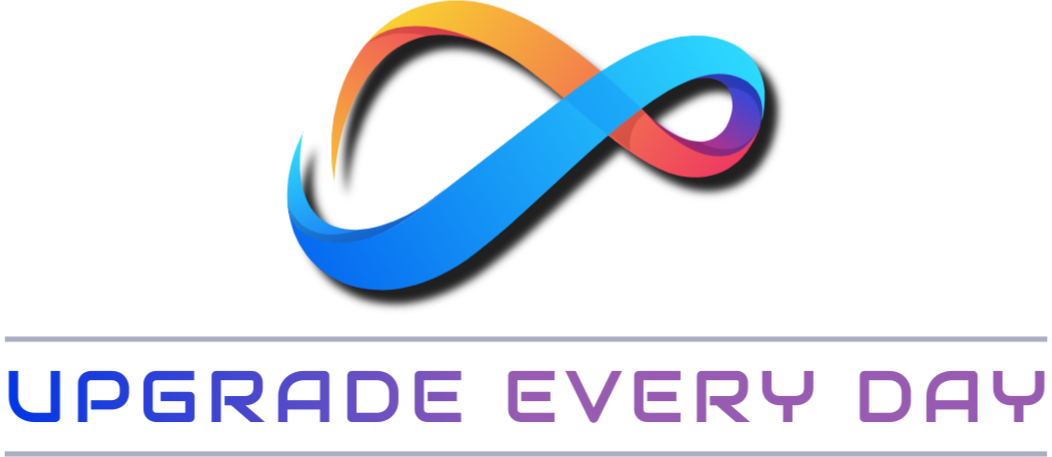Did you know Twitter (X) boasts over 330 million users each month? It’s a goldmine for digital marketers wanting to engage with audiences. A smart content strategy on Twitter is vital. It makes your brand shine in the crowded space and boosts audience interaction.
Here, I’ll show you my Twitter Content Planning steps. It focuses on engagement stats, knowing your audience, exploring hashtags, watching trends, and refining campaigns. These steps can expand your brand’s influence, foster connections, and maximise Twitter’s benefit for your marketing ventures.
Key Takeaways:
- Twitter’s vast user base offers a rich field for digital marketing and engagement.
- Standing out requires a sharp Twitter content strategy to hit your marketing targets.
- Essential strategy parts include engagement analytics, knowing your audience, hashtag use, trend tracking, and refining campaigns.
- Implementing these strategies boosts your brand’s visibility and engages your audience, meeting your marketing needs.
- Constantly refining your X or Twitter strategy with data and feedback is crucial to improve outcomes continuously.
Setting Goals for Twitter Success
To succeed on Twitter, start with clear goals. A sharp Twitter content strategy is key. Goals guide your efforts and let you track progress. This helps you make better choices for your strategy.
Your goals might involve growing brand awareness, increasing engagement, or getting more conversions. By setting these goals, you create a plan for your Twitter content. This plan helps you choose what to post and how to measure success.
Imagine your aim is to boost brand awareness. You’d share content that highlights what makes your brand special. You’d track impressions and follower growth to see if your plan is working.
If you want more engagement, focus on interactions like likes and retweets. Create content that starts conversations. This builds a community around your brand, increasing your Twitter impact.
Remember, setting goals shapes your Twitter strategy. It gives your work purpose and direction. This means you can create content that truly speaks to your audience and achieves your aims.
Measuring Success with Metrics
It’s vital to track metrics to see if your Twitter strategy works. These metrics show how your tweets perform. They help you make informed decisions.
Important metrics include:
- Impressions: How often people see your tweets
- Engagement: How people interact with your tweets
- Click-through’s: How many click on links in your tweets
- Followers: How your follower base grows and engages
- Conversions: Actions users take because of your Twitter activity
Keep an eye on these metrics to understand your impact. This insight lets you tweak your strategy. Over time, you’ll see better results.
Analysing Your Audience and Content Performance
Knowing who follows you on Twitter and how well your tweets do is key to doing well on this platform. Twitter analytics help you see what your audience likes and how effective your tweets are. This info lets you shape your strategies to have the most impact.
With Twitter analytics, you get many metrics to check your tweets’ success. Metrics like impressions, replies, and click-through’s give you info on how your audience sees your content.
Impressions show how many people saw your tweet, indicating its reach.
Replies show how much people are interacting.
Click-through’s tell you how much action your tweet is getting.
Analysing these details helps you understand what content works best with your Twitter followers. You might find that some topics, formats, or tones get more engagement and clicks.
Knowing your audience and how your content performs makes your tweets more precise and relevant.
This knowledge lets you improve your Twitter content planning strategy, making more content that gets good results. Trying out different approaches helps find the best way to engage your audience.
The secret to good Twitter marketing is making content that matches what your audience likes. Knowing their likes can help you make engaging and interesting content.
Twitter Analytics: A Closer Look
Twitter analytics offer a full view of your account’s performance, giving insights into your audience’s actions and likes.
Twitter analytics have several key features and metrics:
| Feature | Description |
|---|---|
| Impressions | How many times people have seen your tweets. |
| Engagement | How often people have interacted with your tweets through likes, replies, retweets, and profile clicks. |
| Top Tweets | Shows your tweets that got the most impressions and engagement. |
| Demographics | Gives information about your audience, like age, gender, and location. |
By keeping an eye on these metrics and understanding your audience better, you can sharpen your Twitter content planning strategy and improve your engagement.

Determining Optimal Posting Times and Frequency
Knowing when your audience is most active on Twitter is vital. As a digital marketer, I’ve seen how understanding my audience’s habits boosts my Twitter performance. By finding the best posting times, I make sure my tweets reach the right people when it matters.
Using scheduling tools is a smart way to find these times. They let you prepare and schedule your tweets to go live when most effective. This saves time and keeps your presence on the platform steady.
Posting regularly at the best times is crucial for Twitter success. It helps your content get noticed amid the noise. This drives more activity to your account and grabs your target audience’s attention.
“By posting during the optimal times, I have witnessed a significant increase in both impressions and engagement on my Twitter account.”
– Paul Nightingale, Digital Marketer
I’ve learned that my audience is most active during lunch and in the evening. By adjusting my schedule, I reach more people at these peak times. This leads to more interactions and engagement with my tweets.
By adopting these methods and using scheduling tools, you can boost your Twitter performance. Analyse your audience, pinpoint the best posting times, and schedule your tweets. Doing so will get your content in front of more eyes, increasing engagement on your account.
| Benefits of Determining Optimal Posting Times and Frequency | Scheduling Tools |
|---|---|
|
|
Creating Relevant and Engaging Content
Creating content that fits your brand and speaks to your audience’s needs is key to Twitter success. You need to offer value, solve problems, and share helpful tips. This makes you a go-to expert in your field. But how can you create content that grabs and keeps their attention?
You must first really get to know your audience. Spend time researching their interests, needs, and challenges.
What are they searching for?
What obstacles do they encounter?
Understanding their unique needs lets you craft content that reaches them effectively.
Then, get creative with your content. Try out different formats like videos, infographics, or polls. By thinking creatively, you’ll stand out and capture your audience’s focus.
The key to engaging content is offering value. Your content should give practical solutions, useful tips, and important info. This makes you a helpful resource, encouraging your followers to keep coming back.
Showcasing your expertise is another good strategy. Share your knowledge and insights to become known as an industry expert. Use thought leadership content, comprehensive guides, or insider tips. Being seen as an authority builds trust and keeps people interested in your content.
Lastly, don’t forget about storytelling. Telling stories can connect with people and spark emotions. Use personal stories, case studies, or customer successes to make your content relatable and unforgettable.
By making your content relevant and engaging, you’ll build a strong relationship with your audience, boost engagement, and succeed on Twitter.
Examples of Creating Relevant and Engaging Content
Here are some ideas to inspire your content:
- A step-by-step guide on solving a common problem in your field
- A video showing how your products are created
- A blog post answering common questions with detailed responses
- A Twitter thread with helpful tips related to your niche
Using Keywords and Hashtags for Discoverability
To boost your content’s visibility on Twitter, it’s crucial to use keywords and hashtags smartly. Inserting the right keywords in your tweets makes them easier for both search engines and users to find. This can help you show up in search results and reach more people.
Hashtags also play a big role in enhancing discoverability and getting more engagement. They let you join ongoing conversations and stand out in trending topics. This increases your chance to attract new followers. Just use one or two fitting hashtags in each tweet to widen your reach.
It’s vital to pick keywords and hashtags that match your content and audience. Consider what your audience might search for. Doing comprehensive research on keywords and hashtags can help you find the best ones for your tweets.
But remember, the key is not to overdo it with irrelevant tags. Aim for a balance between being discoverable and relevant. Stay true and genuine to connect well with your audience.

Why Keywords Matter
Keywords are essential for making your content more visible on search engines like Google. Including the right keywords can make your tweets more visible in search results. This boosts your visibility and draws more organic traffic to your Twitter page.
Think about what your audience is searching for. What keywords might they use? Aligning your tweets with these keywords can help you appear in relevant searches. This increases your chance to catch the eye of potential new followers.
“By incorporating relevant keywords into your tweets, you increase the chances of your content being indexed and displayed in search engine results pages (SERPs).” – Twitter Expert
Maximising Hashtag Impact
Using hashtags effectively can boost your Twitter engagement and visibility. They let you be a part of bigger conversations and trending topics. When picking hashtags, make sure they’re in line with your content and what your audience enjoys.
Look for popular hashtags within your field or interest and use them in your tweets. This helps your content show up in hashtag searches, leading more people to discover it. Unique branded hashtags can also create a community around your brand.
The trick is to find the right mix of popular and niche hashtags. While popular ones have more viewers, they’re also more competitive. Niche hashtags might reach a smaller group but they’re often more relevant to your audience.
| Key Tips for Effective Keyword and Hashtag Usage on Twitter |
|---|
| 1. Research relevant keywords and hashtags that align with your content and target audience. |
| 2. Incorporate keywords naturally into your tweets to improve search engine discoverability. |
| 3. Use one or two relevant hashtags per tweet to increase discoverability and engagement. |
| 4. Strike a balance between popular and niche hashtags to maximise impact. |
| 5. Monitor the performance of your keywords and hashtags and adjust your strategy accordingly. |
Diversifying Your Twitter Content
To keep your Twitter account fresh and draw more attention, you need to diversify your content. Consider adding different content types like videos, polls, and interactive elements, besides just links to your blog.
Videos can really grab your audience’s attention and boost engagement. They can be tutorials, product demos, or behind-the-scenes looks. Videos make your message more engaging and memorable.
Polls are a great way to engage your followers. They let you ask questions and get opinions. This builds community and gives you insight into your audience’s views.
Using Twitter Spaces can also add variety to how you connect with followers. With live audio chats, you can discuss topics, share insights, or host Q&As. It’s a unique way to engage beyond the main feed.
Trying out different content types makes your Twitter feed stand out. Keeping your feed varied keeps your audience entertained and interested. It caters to diverse preferences, attracting more followers.
Here’s a table showing how you can vary your Twitter content:
| Type of Content | Description |
|---|---|
| Videos | Share informative or entertaining videos related to your industry or brand. |
| Polls | Ask questions and gather opinions from your followers, increasing engagement and fostering a sense of community. |
| Infographics | Create visually appealing and shareable infographics to convey information in a concise and attractive way. |
| Behind-the-scenes | Offer a glimpse into your brand’s behind-the-scenes activities or events to create a connection with your audience. |
| Live content | Host live streams, webinars, or Q&A sessions to interact with your followers in real time. |
It’s wise to see which content types your audience likes best. Try different things and adjust based on what works. Feedback and engagement can lead you in the right direction.

Diversifying your Twitter content planning strategies is key to standing out and keeping followers hooked. So, be bold and inventive with your Twitter plan! It pays to be different.
Twitter or X Content Planning Conclusion
Twitter marketing is key for increasing engagement, brand visibility, and reach. A well-planned content strategy and clear goals are essential. Analyse your audience and how your content performs. Then, tweak your approach to get better results. Always use data and feedback to improve your strategy.
By planning your Twitter content wisely, you can make your brand more visible. Provide valuable content consistently to become an authority in your field. This builds strong connections with your followers. Use metrics to track your performance and find ways to get better results.
Twitter is a great platform for businesses to engage with their audience. Use a mix of interesting content, the right keywords, and different content formats. This way, you’ll stand out and leave a lasting impression. Let Twitter marketing help you meet your business goals. Enjoy the benefits of higher engagement and more visibility for your brand.
FAQ
Why is having a solid Twitter content strategy important?
A solid Twitter content strategy is key because it helps set clear goals. It lets you understand your audience and what content works best. Also, you’ll know when to post and how to engage followers with the right keywords and hashtags.
How do I set goals for Twitter success?
To set Twitter goals, first decide what you want to achieve, like more followers or sales. Clear goals let you track your success and tweak your strategy to do better.
Why is analysing audience and content performance important?
Understanding your audience and how your content performs is crucial. It shows what your followers like. Using Twitter analytics, you can see which tweets hit the mark and adjust your posts for better results.
How do I determine optimal posting times and frequency?
Find out when your followers are usually online. Use tools to schedule your tweets for these times. Posting regularly when your audience is active boosts your account’s activity.
How can I create relevant and engaging content?
To create great content, focus on offering value and solving your audience’s problems. Be creative to stand out as a go-to expert in your field.
How do I use keywords and hashtags effectively on Twitter?
Use specific keywords in your tweets to help people and search engines find your posts. Add one or two relevant hashtags per tweet to engage more people and join bigger conversations.
How can I diversify my Twitter content?
To vary your Twitter content, mix in videos, polls, and other interactive posts. Try out Twitter Spaces for live chats and explore different content types to be more noticeable.
How do I optimise my Twitter marketing strategy?
To improve your Twitter strategy, keep evaluating and adjusting based on the results and feedback. Change your approach as needed to keep getting better results, engage more people, and meet your business aims.





